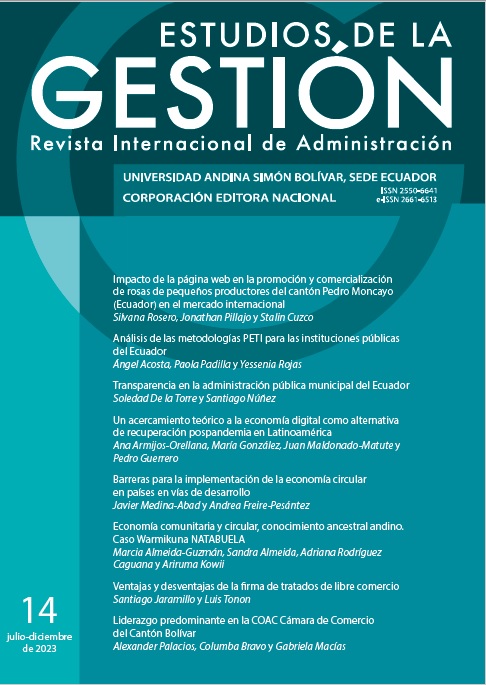Ventajas y desventajas de la firma de tratados de libre comercio
DOI:
https://doi.org/10.32719/25506641.2023.14.7Palabras clave:
comercio internacional, política comercial, integración económica, libre comercio, convenios internacionalesResumen
La razón de esta investigación fue examinar las diferentes contradicciones que existen en la comunidad científica acerca de las ganancias o pérdidas que puede acarrear la firma de tratados de libre comercio (TLC). Al no existir estudios similares en los últimos años, la necesidad de este estudio era sustancial. El objetivo principal de la investigación fue analizar la teoría presentada por parte de los autores acerca de las ventajas y desventajas presentes en la firma de TLC. A través de una revisión de literatura, se seleccionaron 44 fuentes científicas de 2016 hasta 2021 en Scopus, Scielo, Sage y Redalyc. Los resultados revelaron que los países industrializados generalmente son los que perciben mayoresventajas relacionadas al libre comercio, mientras que los países que no se encuentran industrializados presentaron desventajas significativas al momento de firmar TLC. Se determinó que los TLC pueden conllevar tanto ganancias como pérdidas dependiendo del contexto de un país, lo importante es aprender a utilizar esta herramienta correctamente.
Descargas
Referencias
Altamirano, Aizailadema. 2019. “Las letras pequeñas de los tratados de libre comercio”. Ecología Política 58: 64-68. https://www.ecologiapolitica.info/?p=12977.
Archana, Vani. 2020. “Does Trade Liberalization Improve Public Health? The Effect of Free Trade Agreements and Multilateralism in Pharmaceutical Sector in India”. International Journal of Health Services 50 (2): 137-146. https://doi.org/10.1177/0020731419896693.
Ariyasajjakorn, Danupon, James Gander, Somchai Ratanakomut y Stephen Reynolds. 2009. “ASEAN FTA, Distribution of Income, and Globalization”. Journal of Asian Economics 20 (3): 327-335. https://doi.org/10.1016/j.asieco.2009.02.009.
Armas, Enrique, y José Rodríguez. 2017. “Foreign Direct Investment and Technology Spillovers in Mexico: 20 Years of NAFTA”. Journal of Technology Management and Innovation 12 (3): 34-47. https://doi.org/10.4067/S0718-27242017000300004.
Baier, Scott, y Jeffrey Bergstrand. 2004. “Economic Determinants of Free Trade Agreements”. Journal of International Economics 64 (1): 29-63. https://doi.org/10.1016/S0022-1996(03)00079-5.
Baier, Scott, Yoto Yotov y Thomas Zylkin. 2019. “On the Widely Differing Effects of Free Trade Agreements: Lessons from Twenty Years of Trade Integration”. Journal of International Economics 116: 206-226. https://doi.org/10.1016/j.jinteco.2018.11.002.
Bustos, Paula. 2011. “Trade Liberalization, Exports, and Technology Upgrading: Evidence on the Impact of MERCOSUR on Argentinian Firms”. American Economic Review 101 (1): 304-340. https://doi.org/10.1257/aer.101.1.304.
Castillo, José. 2021. “The Impact of Free Trade Agreements in National Markets: Evidence from the Telecommunications Sector in Latin America”. Review of International Economics 29 (4): 860-903. https://doi.org/10.1111/roie.12512.
Clausing, Kimberly. 2001. “Trade Creation and Trade Diversion in the Canada - United States Free Trade Agreement”. Canadian Journal of Economics 34 (3): 677-696. https://doi.org/10.1111/0008-4085.00094.
Colla-De-Robertis, Esteban, y Rafael Garduno. 2021. “The Effect of a Free Trade Agreement with the United States on Member Countries’ per Capita GDP: A Synthetic Control Analysis”. Regional Science Policy & Practice 13 (4): 1129-1145. https://doi.org/10.1111/rsp3.12402.
De la Torre, Martín. 2020. “Chinese Trade Bilateralism and Latin America: The Case of China-Chile Free Trade Agreement”. México y la cuenca del Pacífico 9 (27): 109-128. https://doi.org/10.32870/mycp.v9i27.687.
Duina, Francesco. 2006. The Social Construction of Free Trade: The European Union, NAFTA, and Mercosur. Nueva Jersey: Princeton University Press.
Flores, Rubén. 2006. “Los tratados de libre comercio impulsados por EUA como una respuesta al fracaso de DOHA. El caso andino”. Historia Actual Online 4 (11): 111-120.
Fouda, Simon, Adama Coulibaly, Mama Keita y Antonio Pedro. 2021. “Potentials of the African Continental Free Trade Area: A Combined Partial and General Equilibrium Modeling Assessment for Central Africa”. African Development Review 33 (3): 452-465. https://doi.org/10.1111/1467-8268.12594.
Gazol, Antonio. 2016. “Libre comercio: tratados y nuevo orden. Un balance”. Economía UNAM 13 (38): 122-130. https://doi.org/10.1016/j.eunam.2016.05.006.
Giraldo, Francisco. 2006. “Antecedentes y posibles ventajas y desventajas del tratado de libre comercio (TLC) para un país como Colombia”. Apuntes del CENES 26 (42): 85-110.
Guo, Chuandao. 2020. “Export Effect of FTA-Based on Smart Economy”. Journal of Physics: Conference Series 1533 (4): 1-6. https://doi.org/10.1088/1742-6596/1533/4/042062.
Hamanaka, Shintaro. 2020. “Why Breakup? Looking into Unsuccessful Free Trade Agreement Negotiations”. International Politics 57 (4): 634-662. https://doi.org/10.1057/s41311-019-00195-7.
Haq, Mirajul, Javeria Saeed y Muhammad Akram. 2021. “Exploring the Advantages and Disadvantages of the China-Pakistan Free Trade Agreement”. China and World Economy 29 (3): 83-103. https://doi.org/10.1111/cwe.12364.
Heyl, Katharine, Felix Ekardt, Paula Roos, Jessica Stubenrauch y Beatrice Garske. 2021. “Free Trade, Environment, Agriculture, and Plurilateral Treaties: The Ambivalent Example of Mercosur, Ceta, and the Eu–Vietnam Free Trade Agreement”. Sustainability 13 (6): 1-24. https://doi.org/10.3390/su13063153.
Jung, Jaewon. 2021. “Economic Transformation and Sustainable Development through Multilateral Free Trade Agreements”. Sustainability 13 (5): 1-18. https://doi.org/10.3390/su13052519.
Juust, Mathias, Priit Vahter y Urmas Varblane. 2021. “Trade Effects of the EU-South Korea Free Trade Agreement in the Automotive Industry”. Journal of East-West Business 27 (1): 1-29. https://doi.org/10.1080/10669868.2020.1732511.
Kayani, Farrukh. 2021. “China’s Mushrooming Free Trade Agreements: New Zealand and China’s Upgraded Free Trade Agreement”. Wseas Transactions on Business and Economics 18: 884-893. https://doi.org/10.37394/23207.2021.18.84.
Krugman, Paul, Maurice Obstfeld y Marc Melitz. 2012. Economía internacional teoría y política. Madrid: Pearson Education.
Magee, Christopher. 2017. “The Increasing Irrelevance of Trade Diversion”. Kyklos 70 (2): 278-305. https://doi.org/10.1111/kykl.12138.
Mochón, Francisco. 2009. Economía, teoría y política. Madrid: McGraw-Hill.
Ndonga, Dennis, Emmanuel Laryea y Murendere Chaponda. 2020. “Assessing the Potential Impact of the African Continental Free Trade Area on Least Developed Countries: A Case Study of Malawi”. Journal of Southern African Studies 46 (4): 773-792. https://doi.org/10.1080/03057070.2020.1767888.
Organización Mundial del Comercio (OMC). 2021. “Regional Trade Agreements.” Accedido febrero de 2021. https://www.wto.org/english/tratop_e/region_e/region_e.htm.
Ricardo, David. 1817. The Principles of Political Economy and Taxation. Nueva York: Dover Publications.
Roy, Amrita, y Somesh Mathur. 2016. “Brexit and India–EU Free Trade Agreement”. Journal of Economic Integration 31 (4): 740-773. https://doi.org/10.11130/jei.2016.31.4.740.
Ruiz, Pablo. 2021. “¿Quién ganó y quién perdió con el TLCAN? Resultados del comercio bilateral México-Estados Unidos sobre la producción, el empleo y la distribución del ingreso”. El Trimestre Económico 88 (352): 1099-1120. https://doi.org/10.20430/ete.v88i352.1272.
Singh, Loitongbam. 2021. “Impact of India-ASEAN Free Trade Agreement: An Assessment from the Trade Creation and Trade Diversion Effects”. Foreign Trade Review 56 (4): 400-414. https://doi.org/10.1177/00157325211021503.
Smith, Adam. 1776. The Wealth of Nations. Ware: Wordsworth Editions. Song, Tao, y Andrzej Cieslik. 2020. “The Effects of Free Trade Agreements on Regional Wages in China”. Economic Systems 44 (3): 1-10. https://doi.org/10.1016/j.ecosys.2020.100772.
Stellian, Rémi, y Jenny Danna-Buitrago. 2017. “Competitividad de los productos agropecuarios colombianos en el marco del tratado de libre comercio con los Estados Unidos: análisis de las ventajas comparativas”. Revista de la CEPAL (122): 139-163. https://doi.org/10.18356/7fc7c097-es.
Su, Qingyi, y Chengwei Zang. 2020. “How Will the Implementation of Zero Tariffs Affect Employment in China?”. China and World Economy 28 (2): 123-142. https://doi.org/10.1111/cwe.12324.
Tuxhorn, Kim. 2019. “Mass Support for Free Trade Agreements and Factor Endowment”. International Journal 74 (4): 537-558. https://doi.org/10.1177/0020702019897271.
Verevis, Samuel, y Murat Üngör. 2021. “What has New Zealand Gained from the FTA with China?: Two Counterfactual Analyses”. Scottish Journal of Political Economy 68 (1): 20-50. https://doi.org/10.1111/sjpe.12260.
Villani, Davide, y Margarita Olivera. 2017. “Potenciales impactos económicos en Argentina y Brasil del acuerdo de libre comercio entre el Mercosur y la Unión Europea”. Ensayos de Economía 27 (50): 103-126. https://doi.org/10.15446/ede.v27n50.66524.
Wang, Ling, Eldon Ball, Lilyan Fulginiti y Alejandro Plastina. 2012. “Accounting for the Impacts of Public Research, R & D Spill-Ins, Extension, and Roads in U.S. Regional Agricultural Productivity Growth, 1980-2004” En Productivity Growth in Agriculture: An International Perspective, editado por Keith Fuglie, Ling Wang y Eldon Ball, 13-31. Cambridge: CAB International.
Whalley, John. 1996. “Why Do Countries Seek Regional Trade Agreements?” En The Regionalization of the World Economy, editado por Jeffrey Frankel, 63-90. Chicago: University of Chicago Press.
Yilmazkuday, Hakan. 2021. “Decomposing the Gains from Trade Through the Standard Gravity Variables”. International Economic Journal 35 (1): 13-45. https://doi.org/10.1080/10168737.2020.1855461.
Zelicovich, Julieta. 2017. “China, los tratados de libre comercio y la gobernanza global del comercio internacional en el siglo XXI”. Estudos Internacionais: Revista de Relações Internacionais Da PUC Minas 4 (3): 113-130. https://doi.org/10.5752/P.2317-773X.2016v4n3p113.












